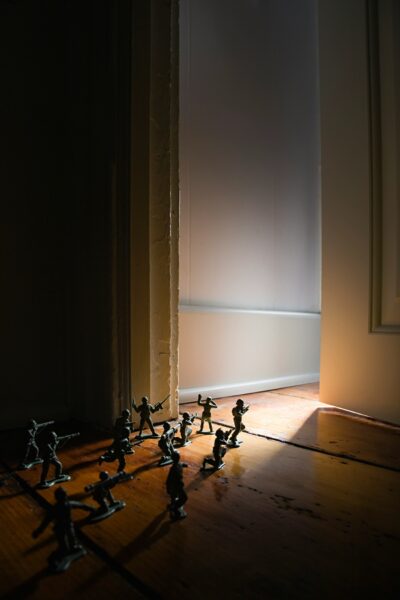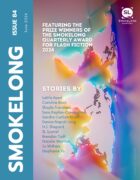“You can’t force these things,” Maryam said as she glided through the first hall in the Illusion Museum, a temporary exhibit set up in the busy shophouses of Bukit Kiara. “Sooner or later everything must come to an end.”
I watched her from a distance as I stood sentry by an abstract reconstruction of Mickey Mouse, or what seemed like Mickey Mouse. The Museum was largely empty that Saturday afternoon, owing to the hundreds of one-to-two-star Google Reviews left by disappointed visitors who didn’t feel illuded enough, or rabid fundamentalists who weren’t impressed by the calligraphy section, which had stirred up a month-long national controversy for distorting – literally – the Arabic word for God; an insult to Islam and, even worse, an insult to Illusion Museums worldwide.
Maryam knew of all this, she just didn’t care. She wanted to go and she knew I didn’t. I had a regular distaste for tacky things, for trite things, the Bukit Kiara Illusion Museum being one of them. But that was the thing about my apprehension, with just the right company I could be persuaded to do just about anything, and I looked at Maryam as she studied a holographic display of our national cars, which didn’t even move, they just stood there looking pretty; just like Maryam, her headscarf a fierce red, faded patterns of old warriors on the chiffon, Maryam didn’t cover all her hair, leaving her fringe to peek out of the front of the headscarf, which was loosely tied around her neck and made her look like the sort of freedom fighter she’d dreamed of, but with the sharp, keen eyes of a local, wandering a dead museum.
“History is the only thing that’s certain,” she said. Maryam read sociology at Idington University Malaysia. She’d make this known one way or another. “And I don’t mean history as it’s said, Ilyas. But history as it’s happened.”
We stepped into the Ames Room, where Maryam for once looked taller, where she dwarfed me and they took a photo of it, which amused her enough to laugh and nudge me on my shoulder, and I felt a jolt of electricity. Maryam had grazed the forces of history before but pulled her punches, afraid of the stench, and I saw this fear in her eyes when we reached the Infinity Well; a dark, cramped, and narrow exhibit where you could simulate a constant fall. I wasn’t sure if it was the space or the movement that had put her off, but she’d been stuck in a closet before. She’d told me this, that she was the first person to develop claustrophobia rather than be born with it, and I knew this wasn’t true, but I entertained it anyway, listening to how she hid in her university broom closet when the cops came to hunt. They were after the producers of a student film, I forget the name, but I was acquainted with the protests against it, like the protests against the museum we were in: orchestrated, but to Maryam they were real, and she hid in the closet for ten hours, she told me. She didn’t make the film, but she did organise its counter-protests, for free speech or for protecting the arts or for liberal values or for protesting just for the sake of protesting. Barely anyone showed up. Idington was a private university, home to students with much to lose and little to fight for, including Maryam, who just didn’t care; until the cops came bursting through the campus gates. She told me how at one point she even heard her full name being called, how she grasped tightly on the handle of a sweep, one of the small ones, she specified — a small duster.
It took so long for them to go away, she told me, and I’d ponder if she meant the cops or for everyone, if she was just waiting for everyone to leave the university while she hid in the closet, and all I could think about was thank god the janitors weren’t on duty that day, but I never told her this. In the end, the protests and counter-protests were for nothing. No one saw the film that no one was gonna see anyway, and the few people arrested for it were let go because they were the right sort of student, or they had the right sort of lawyers.
The same was the case with the calligraphy section, at which we’d finally arrived, and Maryam smirked once she saw my astonished face. After all this and it’s not been removed, I exclaimed, but she said nothing, and we walked into the hall of curved mirrors, interspersed with curved walls of seemingly random texts in various languages. I didn’t get the point, but I looked at the writing and knew how to read Arabic and languages like it, but I didn’t find it, didn’t find the word for God.
“Maybe they removed it,” I said.
“Lies,” claimed Maryam, her dark hands pulling at her jubah. It was starting to freeze. “I visited before the whole thing. It didn’t exist to begin with.”
“God was never here,” I replied, smiling, but Maryam didn’t share my humour, she just waited for my anger, which never came. I didn’t want to be like the protestors, I didn’t want to get mad at abstractions, at arbitrary things, and that’s what the exhibition was to me: an arbitrary thing for people to coalesce around, for politicians to count their votes. But Maryam stared at the text, wanting it to end, ashamed for waiting in the closet, where she prolonged the inevitable. I hadn’t yet developed her fury, hadn’t shared her regrets, so I looked to the other side, at the curved mirrors, seeing myself in inflated form. I witnessed the reflections bounce off of each other in an infinite array, and I hoped never to see the finishing line, never to lose Maryam.



 The SmokeLong Grand Micro Contest (The Mikey) is now an annual competition celebrating and compensating the best micro fiction and nonfiction online.
The SmokeLong Grand Micro Contest (The Mikey) is now an annual competition celebrating and compensating the best micro fiction and nonfiction online.